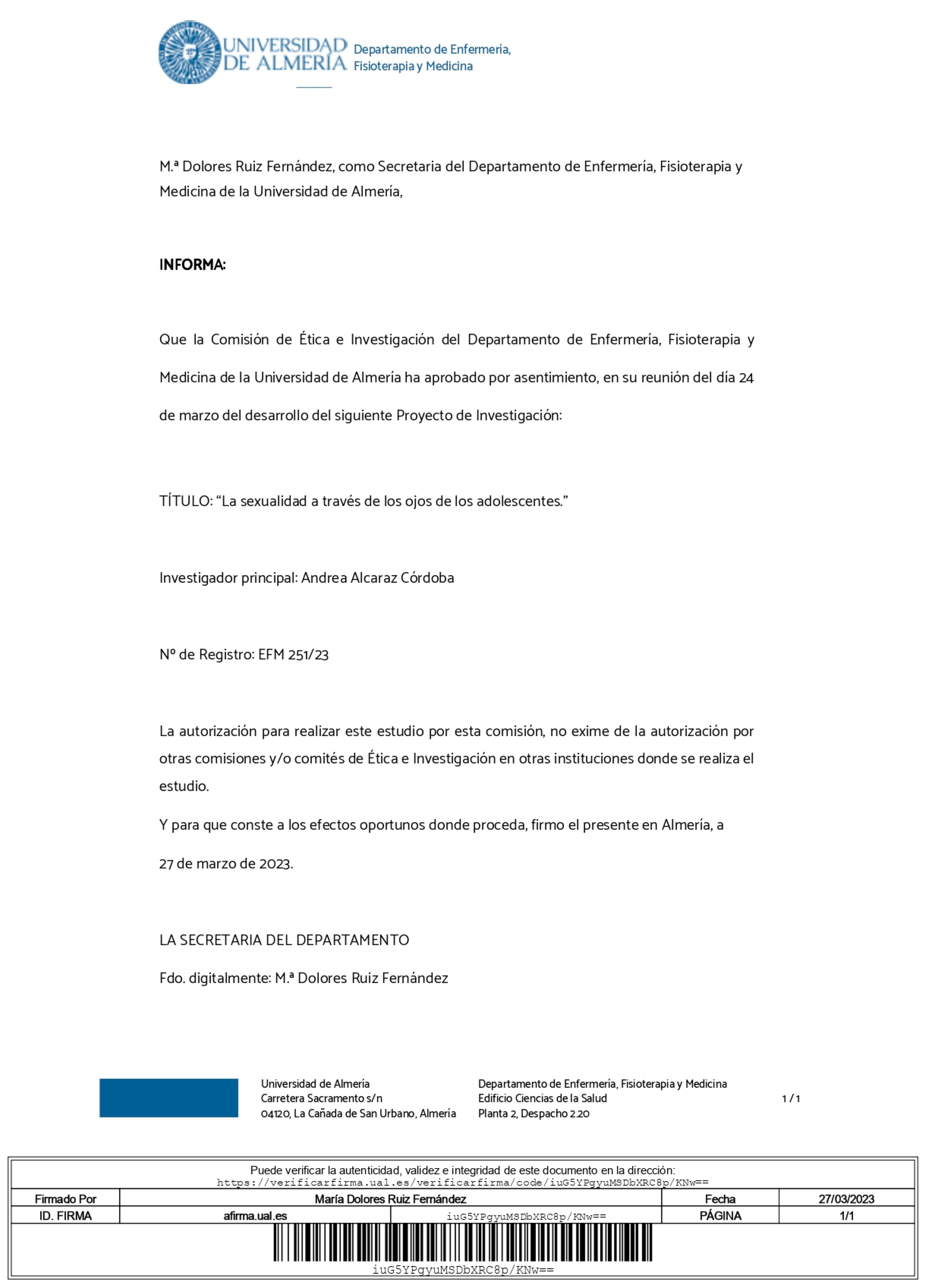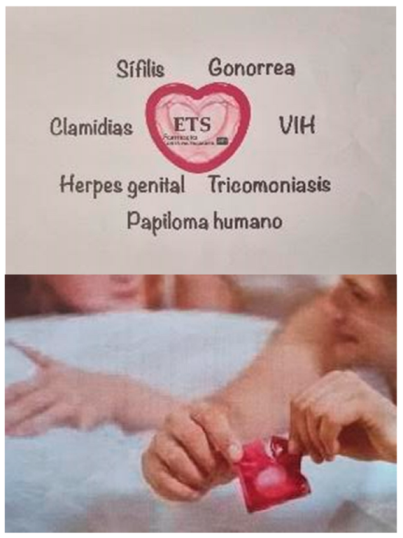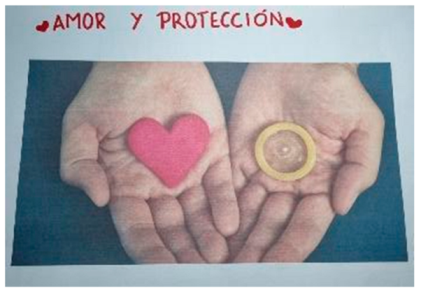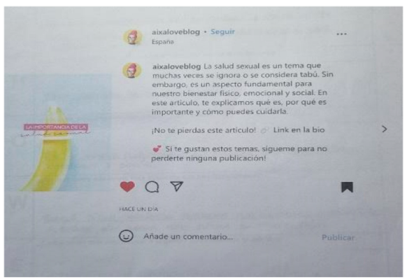Adolescents’ Perceptions of Sexuality: A Qualitative Study
Abstract
1. Introduction
2. Materials and Methods
2.1. Study Design
2.2. Participants and Data Collection
2.3. Procedure and Data Analysis
2.4. Rigor
2.5. Ethical Considerations
3. Results
3.1. Towards a Culture of Preventing STIs and Promoting Healthy Sexual Practices
3.1.1. STIs and Traditional Methods of Protection
“STIs are very much related to our health, as they are diseases that we can have and affect us for life...”.(S2)
“...it is important to know the different methods of protection available and how they are used in order to have a good sexual relationship”.(FG3)
“...because they did not know the consequences of not using protection methods or they knew about them, but ignored them”.(S10)
“STIs are very common in young people because they do not use contraceptive methods that reduce their transmission”.(S2)
“STIs are an issue that is very present in our lives, yet there is very little understanding of them”.(S1)
“Before having sex, make sure that the condom is on properly, check the expiry date and that it is not defective or broken. They should also be stored in a cool place to avoid breakage”.(S20)
“...if you use condoms you can avoid catching diseases, and it is a popular method because of its effectiveness”.(S12)
3.1.2. Love and Self-Esteem as Key Factors of Prevention
“(Moderator: How can we prevent STIs?) I feel that mainly loving yourself because accepting something (unprotected sex) that you know is going to be bad for your health means that you don’t love yourself as much as you should”.(FG5)
“...feeling insecure and having low self-esteem can make you have unprotected sex even if you don’t want to... because you want the other person to like you and feel like other people”.(FG2)
“The message that this photograph can give us is that if a person loves you, they also care for you and look after what is best for both of you”.(FG1)
“We can also protect the people we love... we are the ones who decide what things we share with our romantic partner”.(S26)
“...because I think that, sometimes, there are men who manipulate their partners by telling them not to use protective measures, and force them to have sex without a condom”.(S24)
“It is foolish to ignore what they teach us in lectures (on sexuality), in addition to a lack of respect towards your partner”.(FG2)
“...that all people are free to love and care about any person as long as they are always thinking of both partners’ well-being so that they are healthy and don’t encounter any problems”.(S12)
3.2. Adolescents’ Needs from Their Perspective
3.2.1. Sexuality in Adolescence
“Sexuality is a fundamental aspect of our physical, emotional and social well-being”.(S14)
“...we only talk about this subject amongst ourselves, I think it’s a bit taboo. I don’t see myself talking about it with my parents...”.(FG3)
“I think that we have a low chance of getting an STI... because this happens to older people or people who are doing it every day”.(FG5)
“Methods of protection were created to prevent unwanted pregnancies, and this is what affects us the most, because it would ruin our lives”.(FG1)
“It is very important to treat this issue naturally and to provide sex education courses, because this will prevent misinformation and avoid contracting diseases”.(S4)
“Sex education lectures have to start as soon as possible to get this information to as many people as possible”.(S14)
3.2.2. Sex Education
“Adolescents also have STIs, as people get infected because they are not fully informed about it”.(S13)
“There are also myths surrounding STIs and pregnancy that still lead to unprotected sexual practices”.(S2)
“Lectures don’t work... my friend has an STI and they have been giving her lectures since secondary school, but she doesn’t pay attention. Coming here, giving a boring lecture and leaving is the same as doing nothing”.(FG5)
“...giving condoms out, bringing people who have an STI to talk about their experience... I mean, real cases, giving more lectures, doing more tests and if they don’t have anything, they can do whatever they want”.(FG1)
“I think they should show images of what happens when you catch a sexually transmitted disease... show the consequences so that people are scared... and so that they are more cautious”.(FG4)
“... we can talk about it amongst ourselves, help spread the word and raise awareness about using protection amongst our friends”.(FG3)
4. Discussion
Limitations
5. Conclusions
Author Contributions
Funding
Institutional Review Board Statement
Informed Consent Statement
Data Availability Statement
Conflicts of Interest
Appendix A. SHOWED Form
| S | What can be seen in the photo? (Describe what you see) | ||
| H | What is happening? (The story behind the image) | ||
| O | How is this related to our life/health? | ||
| W | Why do you think the situation in the photograph exists? | ||
| E | How can this photo educate people? (What message it can send) | ||
| D | What can we do to improve the situation? | ||
| Note: The researchers explained the term “SHOWED” to the participants and responded to any queries prior to the data collection process. | |||
Appendix B. Permission from the Ethics Committee
| Univeristy of Almería | Department of Nursing, Physiotherapy and Medicine |
| Carretera Sacramento s/n | Health Sciences Building |
| 04120, La Cañada de San Urbano, Almería | 2nd floor, Office 2.20 |
| Signed by | María Dolores Ruiz Fernández | Date | 27 March 2023 |
| ID Signature | afirma.ual.es | Page | 1/1 |
Appendix C. Permission from the Ethics Committee Spanish Version

Appendix D. Consent Form
- Why is the study being conducted? Numerous studies have identified that adolescents are at increased risk of acquiring sexually transmitted infections (STIs), which is a serious public health problem. Education is essential to promote healthy sexuality, as well as to prevent gender-based violence and eliminate sexist attitudes. The Photovoice technique has been used to explore a variety of community health issues, including sex education. This study aims to engage adolescents in creating awareness, express perspectives on sexuality in everyday life, develop perceptions in line with equal rights, as well as reflect on misguided sexual beliefs.
- What is it about? The aim of the study is to explore perceptions and attitudes about STIs and prevention methods among adolescents.
- How will the data collected be handled? The processing, communication and transfer of personal data of all participating subjects will be in accordance with the provisions of Organic Law 15/1999 of 13th December on the protection of personal data.
- Can I withdraw my child from the study? You should know that your child’s participation in this study is voluntary and that you can decide not to participate and withdraw consent at any time, without any consequences.
- −
- I declare that I have been informed of the purpose and procedures of this study, as well as the possibility of declining to participate in the study.
- −
- I understand that my child’s participation is completely voluntary and that if at any time I wish to withdraw my consent, I may do so.
- −
- I understand that the anonymity and confidentiality of the data will be maintained, and they will be handled in accordance with the Organic Law on the Protection of Personal Data 15/99.
References
- Aguirrebengoa, O.A.; Garcia, M.V.; Sanchez, M.R.; D’Elia, G.; Méndez, B.C.; Arrancudiaga, M.A.; León, S.B.; López, T.P.; Escribano, P.C.; Martín, J.B.; et al. Risk factors associated with sexually transmitted infections and HIV among adolescents in a reference clinic in Madrid. PLoS ONE 2020, 15, e0228998. [Google Scholar] [CrossRef] [PubMed]
- De Peder, L.D.; Mesquita-da Silva, C.; Nascimento, B.L.; Malizan, J.A.; Madeira, H.S.; Horvath, J.D.; Silva, E.S.; Teixeira, J.J.V. Prevalence of Sexually Transmitted Infections and Risk Factors Among Young People in a Public Health Center in Brazil: A Cross-Sectional Study. J. Pediatr. Adolesc. Gynecol. 2020, 33, 354–362. [Google Scholar] [CrossRef] [PubMed]
- Gupta, N. Sexually Transmitted Infections: Part I: Genital Bumps and Genital Ulcers. Pediatr. Rev. 2020, 41, 455–466. [Google Scholar] [CrossRef] [PubMed]
- García-Vázquez, J.; Quintó, L.; Agulló-Tomás, E. Impact of a sex education programme in terms of knowledge, attitudes and sexual behaviour among adolescents in Asturias (Spain). Glob. Health Promot. 2020, 27, 122–130. [Google Scholar] [CrossRef] [PubMed]
- Grubb, L.K. Barrier protection use by adolescents during sexual activity. Pediatrics 2020, 146, e2020007237. [Google Scholar] [CrossRef]
- Nigussie, T.; Yosef, T. Knowledge of sexually transmitted infections and its associated factors among polytechnic college students in Southwest Ethiopia. Pan Afr. Med. J. 2020, 37, 1–11. [Google Scholar] [CrossRef]
- Crowley, J.S.; Geller, A.B.; Vermund, S.H. Sexually Transmitted Infections: Adopting a Sexual Health Paradigm; National Academies of Sciences, Engineering, and Medicine; Health and Medicine Division; Board on Population Health and Public Health Practice; Committee on Prevention and Control of Sexually Transmitted Infections in the United States; National Academies Press: Washington, DC, USA, 2021; pp. 1–750. [Google Scholar]
- Gottlieb, S.L.; Low, N.; Newman, L.M.; Bolan, G.; Kamb, M.; Broutet, N. Toward global prevention of sexually transmitted infections (STIs): The need for STI vaccines. Vaccine 2014, 32, 1527–1535. Available online: https://pubmed.ncbi.nlm.nih.gov/24581979/ (accessed on 4 October 2023). [CrossRef]
- Fonseca, S.; Lacerda, L.; Teixeira, C.; Reis-Melo, A.; Tavares, M. Sexually transmitted infections in Portuguese adolescents. An. Pediatría 2022, 96, 454–455. [Google Scholar] [CrossRef]
- Sentís, A.; Martin-Sanchez, M.; Arando, M.; Vall, M.; Barbera, M.J.; Ocaña, I.; Cordón, A.G.; Alsina, M.; Martin-Ezquerra, G.; Knobel, H.; et al. Sexually transmitted infections in young people and factors associated with HIV coinfection: An observational study in a large city. BMJ Open 2019, 9, e027245. [Google Scholar] [CrossRef]
- Shannon, C.L.; Klausner, J.D. The Growing Epidemic of Sexually Transmitted Infections in Adolescents: A Neglected Population. Curr. Opin. Pediatr. 2018, 30, 137. [Google Scholar] [CrossRef]
- Garzón-Orjuela, N.; Samacá-Samacá, D.; Moreno-Chaparro, J.; Ballesteros-Cabrera, M.D.P.; Eslava-Schmalbach, J. Effectiveness of Sex Education Interventions in Adolescents: An Overview. Compr. Child Adolesc. Nurs. 2021, 44, 15–48. [Google Scholar] [CrossRef] [PubMed]
- Deleon-de Melo, L.; Passos-Sodré, C.; Spindola, T.; Costa-Martins, E.R.; Nepomuceno-de Oliveira André, N.L.; Vieira-da Motta, C.V. Prevention of sexually transmitted infections among young people and the importance of health education. Enfermería Glob. 2022, 21, 74–115. [Google Scholar]
- Silva, C.F.; Silva, I.; Rodrigues, A.; Sá, L.; Beirão, D.; Rocha, P.; Santos, P. Young People Awareness of Sexually Transmitted Diseases and Contraception: A Portuguese Population-Based Cross-Sectional Study. Int. J. Environ. Res. Public Health 2022, 19, 13933. [Google Scholar] [CrossRef] [PubMed]
- Zulu, J.M.; Blystad, A.; Haaland, M.E.S.; Michelo, C.; Haukanes, H.; Moland, K.M. Why teach sexuality education in school? Teacher discretion in implementing comprehensive sexuality education in rural Zambia. Int. J. Equity Health 2019, 18, 116. [Google Scholar] [CrossRef]
- Visalli, G.; Cosenza, B.; Mazzù, F.; Bertuccio, M.P.; Spataro, P.; Pellicanò, G.F.; Di Pietro, A.; Picerno, I.; Facciolà, A. Knowledge of sexually transmitted infections and risky behaviours: A survey among high school and university students. J. Prev. Med. Hyg. 2019, 60, E84–E92. [Google Scholar]
- Crocker, B.C.S.; Pit, S.W.; Hansen, V.; John-Leader, F.; Wright, M.L. A positive approach to adolescent sexual health promotion: A qualitative evaluation of key stakeholder perceptions of the Australian Positive Adolescent Sexual Health (PASH) Conference. BMC Public Health 2019, 19, 681. [Google Scholar] [CrossRef]
- El Kazdouh, H.; El-Ammari, A.; Bouftini, S.; El Fakir, S.; El Achhab, Y. Perceptions and intervention preferences of Moroccan adolescents, parents, and teachers regarding risks and protective factors for risky sexual behaviors leading to sexually transmitted infections in adolescents: Qualitative findings. Reprod. Health 2019, 16, 138. [Google Scholar] [CrossRef]
- Fernández-Rouco, N.; Fernández-Fuertes, A.A.; Martínez-Álvarez, J.L.; Carcedo, R.J.; Orgaz, B. What do Spanish adolescents know (or not know) about sexuality? An exploratory study. J. Youth Stud. 2019, 22, 1238–1254. [Google Scholar] [CrossRef]
- Leung, H.; Shek, D.T.L.; Leung, E.; Shek, E.Y.W. Development of Contextually-relevant Sexuality Education: Lessons from a Comprehensive Review of Adolescent Sexuality Education Across Cultures. Int. J. Environ. Res. Public Health 2019, 16, 621. [Google Scholar] [CrossRef]
- Goldfarb, E.S.; Lieberman, L.D. Three Decades of Research: The Case for Comprehensive Sex Education. J. Adolesc. Health 2021, 68, 13–27. [Google Scholar] [CrossRef]
- Shangase, N.; Kharsany, A.B.M.; Ntombela, N.P.; Pettifor, A.; McKinnon, L.R. A Systematic Review of Randomized Controlled Trials of School Based Interventions on Sexual Risk Behaviors and Sexually Transmitted Infections among Young Adolescents in Sub-Saharan Africa. AIDS Behav. 2021, 25, 3669. [Google Scholar] [CrossRef] [PubMed]
- Jacinto-Cárdenas, R.; Sánchez-Ceuvas, M.; Torres-Álvarez, M.A.D.C.; Ruíz-Paloalto, M.L. Mentoría como intervención de enfermería para el empoderamiento adolescente en la salud reproductiva. Horiz. Sanit. 2020, 19, 103–114. [Google Scholar] [CrossRef]
- Santelli, J.S.; Kantor, L.M.; Grilo, S.A.; Speizer, I.S.; Lindberg, L.D.; Heitel, J.; Schalet, A.T.; Lyon, M.E.; Mason-Jones, A.J.; McGovern, T.; et al. Abstinence Only Until Marriage: An Updated Review of U.S. Policies and Programs and Their Impact. J. Adolesc. Health 2017, 61, 273–280. [Google Scholar] [CrossRef] [PubMed]
- Ozamiz-Etxebarria, N.G.N.; Jaureguizar, J.; Redondo, I. Cyber Dating Violence Prevention Programs in Universal Populations: A Systematic Review. Psychol. Res. Behav. Manag. 2020, 13, 1089. [Google Scholar]
- Racionero-Plaza, S.; Ugalde, L.; Merodio, G.; Gutiérrez-Fernández, N. Architects of Their Own Brain. Social Impact of an Intervention Study for the Prevention of Gender-Based Violence in Adolescence. Front. Psychol. 2020, 10, 3070. [Google Scholar] [CrossRef]
- Forcadell-Díez, L.; Benlliure, J.B.; Martínez, C.; Pérez, G. An in-depth analysis of the sexuality needs of Barcelona’s youth: A holistic view using mixed method. Sex. Reprod. Health Matters 2022, 30, 2135728. [Google Scholar] [CrossRef]
- Coronado, C.; Freijomil-Vázquez, C.; Fernández-Basanta, S.; Andina-Díaz, E.; Movilla-Fernández, M.J. Using photovoice to explore the impact on a student community after including cross-sectional content on environmental sustainability in a university subject: A case study. Int. J. Sustain. High. Educ. 2020, 21, 1331–1350. [Google Scholar] [CrossRef]
- Andina-Díaz, E. Using Photovoice to stimulate critical thinking: An exploratory study with Nursing students. Rev. Lat. Am. Enferm. 2020, 28, 1–7. [Google Scholar] [CrossRef]
- Lofton, S.; Norr, K.F.; Jere, D.; Patil, C.; Banda, C. Youth Photovoice: Promoting Youth-Driven Community Changes for HIV Prevention in Rural Malawi. J. Assoc. Nurses AIDS Care JANAC 2021, 32, e77–e90. [Google Scholar] [CrossRef]
- Bayer, A.M.; Alburqueque, M. Our world through our eyes: Adolescents use photovoice to speak their mind on adolescent health, well-being, and sexuality in Lima, Peru. Health Promot. Pract. 2014, 15, 723–731. [Google Scholar] [CrossRef]
- Malka, M.; Lotan, S. Beyond the Risk Discourse: Photovoice as Critical-Pedagogical Tool of Sexuality Education for Adolescents. Sex. Res. Soc. Policy 2023, 20, 103–119. [Google Scholar] [CrossRef]
- Cardoso, R.B.; Caldas, C.P.; Brandão, M.A.G.; de Souza, P.A.; Santana, R.F. Healthy aging promotion model referenced in Nola Pender’s theory. Rev. Bras. De Enferm. 2021, 75, e20200373. Available online: https://pubmed.ncbi.nlm.nih.gov/34586194/ (accessed on 6 October 2023). [CrossRef] [PubMed]
- Teti, M.; Murray, C.; Johnson, L.S.; Binson, D. Photovoice as a community-based participatory research method among women living with HIV/AIDS: Ethical opportunities and challenges. J. Empir. Res. Hum. Res. Ethics JERHRE 2012, 7, 34–43. Available online: https://pubmed.ncbi.nlm.nih.gov/23086046/ (accessed on 3 October 2023). [CrossRef] [PubMed]
- Musoke, D.; Boynton, P.; Butler, C.; Musoke, M.B. Health seeking behaviour and challenges in utilising health facilities in Wakiso district, Uganda. Afr. Health Sci. 2014, 14, 1046–1055. [Google Scholar] [CrossRef]
- Solano-Ruiz, M.c.C.; Andina-Díaz, E.; Noreña-Peña, A.L.; Siles-González, J. Photovoice and dramatisation in the classroom with nursing students: An exploratory study to raise awareness of the cultural and social dimensions of violence against women. Nurse Educ. Today 2021, 103, 104974. [Google Scholar] [CrossRef] [PubMed]
- Nykiforuk, C.I.J. Engaging patients in research using photovoice methodology. CMAJ Can. Med. Assoc. J. 2021, 193, E1050. [Google Scholar] [CrossRef]
- Evans-Agnew, R.A.; Boutain, D.M.; Rosemberg, M.-A.S. Advancing Nursing Research in the Visual Era: Reenvisioning the Photovoice Process Across Phenomenological, Grounded Theory, and Critical Theory Methodologies. Adv. Nurs. Sci. ANS 2017, 40, E1–E15. [Google Scholar] [CrossRef]
- Boamah, S.A.; Yous, M.L.; Weldrick, R.; Havaei, F.; Ganann, R. Using Photovoice as a Method for Capturing the Lived Experiences of Caregivers During COVID-19: A Methodological Insight. Int. J. Qual. Methods 2022, 21, 1–11. Available online: https://pubmed.ncbi.nlm.nih.gov/36406279/ (accessed on 3 October 2023). [CrossRef]
- Tong, A.; Sainsbury, P.; Craig, J. Consolidated criteria for reporting qualitative research (COREQ): A 32-item checklist for interviews and focus groups. Int. J. Qual. Health Care 2007, 19, 349–357. Available online: https://academic.oup.com/intqhc/article/19/6/349/1791966 (accessed on 23 January 2022). [CrossRef]
- Egea, F.J.; Torrente, R.G.; Aguilar, A. An efficient agro-industrial complex in Almería (Spain): Towards an integrated and sustainable bioeconomy model. New Biotechnol. 2018, 40, 103–112. [Google Scholar] [CrossRef]
- Instituto Nacional de Estadística (INE). Cifras Oficiales de Población de los Municipios Españoles; Instituto Nacional de Estadística (INE): Santiago, Chile, 2022. [Google Scholar]
- Wallerstein, N.; Bernstein, E. Empowerment education: Freire’s ideas adapted to health education. Health Educ. Q. 1988, 15, 379–394. Available online: https://pubmed.ncbi.nlm.nih.gov/3230016/ (accessed on 6 October 2023). [CrossRef] [PubMed]
- Morse, J.M. Critical Analysis of Strategies for Determining Rigor in Qualitative Inquiry. Qual. Health Res. 2015, 25, 1212–1222. Available online: https://pubmed.ncbi.nlm.nih.gov/26184336/ (accessed on 6 October 2023). [CrossRef] [PubMed]
- Lincoln, Y.; Guba, E.G. Naturalistic Inquiry; Sage: Los Angeles, CA, USA, 1985. [Google Scholar]
- World Medical Association. Declaration of Helsinki: Ethical principles for medical research involving human subjects. JAMA 2013, 310, 2191–2194. [Google Scholar] [CrossRef]
- Boletín Oficial del Estado (BOE). Ley Orgánica del Gobierno de España 3/2018, del 5 de Diciembre, de Protección de Datos Personales y Garantía de los Derechos Digitales; Boletín Oficial del Estado (BOE): Madrid, Spain, 2018; Volume 294, Available online: https://www.boe.es/eli/es/lo/2018/12/05/3/com (accessed on 6 October 2023).
- Inthavong, K.; Ha, L.T.H.; Anh, L.T.K.; Sychareun, V. Knowledge of safe sex and sexually transmitted infections among high school students, Vientiane Prefecture, Lao PDR. Glob. Health Action 2020, 13, 1785179. [Google Scholar] [CrossRef] [PubMed]
- Koray, M.H.; Adomah-Afari, A.; Punguyire, D.; Naawa, A. Knowledge of sexually transmitted infections among senior high school adolescents in the Wa Municipality of Ghana. Glob. Health J. 2022, 6, 95–101. [Google Scholar] [CrossRef]
- Rodríguez-Mármol, M.; Muño-Cruz, R.; Sánchez-Muñoz, I. Conocimientos y actitudes sobre sexualidad en adolescentes de primer curso de Grado en Educación Infantil y Primaria de la Universidad de Jaén. Enfermería Glob. 2016, 15, 164–173. [Google Scholar] [CrossRef][Green Version]
- Cegolon, L.; Bortolotto, M.; Bellizzi, S.; Cegolon, A.; Bubbico, L.; Pichierri, G.; Mastrangelo, G.; Xodo, C. A Survey on Knowledge, Prevention, and Occurrence of Sexually Transmitted Infections among Freshmen from Four Italian Universities. Int. J. Environ. Res. Public Health 2022, 19, 897. [Google Scholar] [CrossRef]
- Fernández-García, O.; Gil-Llario, M.D.; Ballester-Arnal, R. Sexual Health among Youth in Residential Care in Spain: Knowledge, Attitudes and Behaviors. Int. J. Environ. Res. Public Health 2022, 19, 12948. [Google Scholar] [CrossRef]
- Nathan, S.F.; Berglas, N.F.; Kaller, S.; Mays, A.; Biggs, M.A. Reasons for Having Unprotected Sex Among Adolescents and Young Adults Accessing Reproductive Health Services. Women’s Health Issues 2022, 33, 222–227. [Google Scholar] [CrossRef]
- Badawi, M.M.; SalahEldin, M.A.; Idris, A.B.; Hasabo, E.A.; Osman, Z.H.; Osman, W.M. Knowledge gaps of STIs in Africa; Systematic review. PLoS ONE 2019, 14, e0213224. [Google Scholar] [CrossRef]
- Oluwole, E.O.; Oyekanmi, O.D.; Ogunyemi, D.O.; Osanyin, G.E. Knowledge, attitude and preventive practices of sexually transmitted infections among unmarried youths in an urban community in Lagos State, Nigeria. Afr. J. Prim. Health Care Fam. Medicine 2020, 12, 1–7. [Google Scholar] [CrossRef] [PubMed]
- Wanje, G.; Masese, L.; Avuvika, E.; Baghazal, A.; Omoni, G.; Scott McClelland, R. Parents’ and teachers’ views on sexual health education and screening for sexually transmitted infections among in-school adolescent girls in Kenya: A qualitative study. Reprod. Health 2017, 14, 95. [Google Scholar] [CrossRef] [PubMed]
- Folasayo, A.T.; Oluwasegun, A.J.; Samsudin, S.; Saudi, S.N.S.; Osman, M.; Hamat, R.A. Assessing the knowledge level, attitudes, risky behaviors and preventive practices on sexually transmitted diseases among university students as future healthcare providers in the central zone of Malaysia: A cross-sectional study. Int. J. Environ. Res. Public Health 2017, 14, 159. [Google Scholar] [CrossRef]
- Apter, D. Contraception options: Aspects unique to adolescent and young adult. Best Pract. Res. Clin. Obstet. Gynaecol. 2018, 48, 115–127. [Google Scholar] [CrossRef] [PubMed]
- Matteelli, A.; Capelli, M.; Sulis, G.; Toninelli, G.; Carvalho, A.C.C.; Pecorelli, S.; Caruso, A.; Bonfanti, C.; Gargiulo, F.; Donato, F. Prevalence of Chlamydia trachomatis and Neisseria gonorrhoeae infection in adolescents in Northern Italy: An observational school-based study. BMC Public Health 2016, 16, 200. [Google Scholar] [CrossRef]
- Ahn, J.; Yang, Y. Relationship Between Self-Esteem and Risky Sexual Behavior among Adolescents and Young Adults: A Systematic Review. Am. J. Sex. Educ. 2022, 1, 484–503. [Google Scholar] [CrossRef]
- Sánchez-Sansegundo, M.; Alarcó-Rosales, R.; Zaragoza-Martí, A.; Quesada-Rico, J.A.; Gabaldón-Bravo, E.; Hurtado-Sánchez, J.A. The Associations of Mental Health Disturbances, Self-Esteem, and Partner Violence Victimization with Condom Use in Spanish Adolescents. J. Clin. Med. 2022, 11, 2467. [Google Scholar] [CrossRef]
- Longo, L.M.; Ertl, M.M.; Pazienza, R.; Agiliga, A.U.; Dillon, F.R.; Martin, J.L. Associations among Negative Urgency, Sensation Seeking, Alcohol Use, Self-Esteem, and Casual Sexual Behavior for College Students. Subst. Use Misuse 2020, 55, 796–805. [Google Scholar] [CrossRef]
- Rodrigues, D.L.; Carvalho, A.C.; Prada, M.; Garrido, M.V.; Balzarini, R.N.; de Visser, R.O.; Lopes, D. Condom Use Beliefs Differ According to Regulatory Focus: A Mixed-Methods Study in Portugal and Spain. J. Sex Res. 2023, 6, 1–18. [Google Scholar] [CrossRef]
- Davis, K.C.; Stappenbeck, C.A.; Masters, N.T.; George, W.H. Young Women’s Experiences with Coercive and Noncoercive Condom Use Resistance: Examination of an Understudied Sexual Risk Behavior. Women’s Health Issues 2019, 29, 231–237. [Google Scholar] [CrossRef]
- Carbonell, Á.; Navarro-Perez, J.-J.; Fernández, I. Sexismo y mitos del amor romántico en adolescentes que residen en centros de acogida. OBETS Rev. Cienc. Soc. 2021, 16, 75–86. [Google Scholar] [CrossRef]
| Participants | Age | Sex | Relationship Status | Do You Know Anyone Who Has Had an STI? | Sex Education Received |
|---|---|---|---|---|---|
| P1-S1/GF1 | 15 | M | S | No | No |
| P2-S2/GF1 | 14 | M | S | No | No |
| P3-S3/GF1 | 16 | F | S | Yes | Yes |
| P4-S4/GF1 | 16 | F | W | No | Yes |
| P5-S5/GF1 | 14 | M | S | No | No |
| P6-S6/GF2 | 16 | F | W | No | Yes |
| P7-S7/GF2 | 14 | F | S | No | No |
| P8-S8/GF2 | 15 | M | S | No | No |
| P9-S9/GF2 | 14 | F | S | Yes | No |
| P10-S10/GF2 | 17 | M | W | No | Yes |
| P11-S11/GF2 | 16 | F | S | No | Yes |
| P12-S12/GF3 | 14 | F | S | No | No |
| P13-S13/GF3 | 15 | F | S | No | No |
| P14-S14/GF3 | 17 | M | S | No | Yes |
| P15-S15/GF3 | 14 | F | S | No | No |
| P16-S16/GF3 | 15 | F | S | No | No |
| P17-S17/GF4 | 14 | F | S | No | No |
| P18-S18/GF4 | 17 | M | W | No | Yes |
| P19-S19/GF4 | 16 | F | W | Yes | Yes |
| P20-S20/GF4 | 16 | F | S | No | Yes |
| P21-S21/GF4 | 15 | M | S | No | No |
| P22-S22/GF5 | 16 | M | S | No | Yes |
| P23-S23/GF5 | 14 | F | S | Yes | No |
| P24-S24/GF5 | 15 | F | W | No | No |
| P25-S25/GF5 | 17 | M | S | No | Yes |
| P26-S26/GF5 | 16 | F | S | No | Yes |
| Category | Subcategory | Codes | Images |
|---|---|---|---|
| Towards a culture of preventing STIs and promoting healthy sexual practices | STIs and traditional methods of protection | STIs, HIV, syphilis, gonorrhoea, chlamydia, condoms, contraceptive pills, unprotected sex |  |
| Love and self-esteem as key factors of prevention | Self-love, loving relationship, maturity, responsibility, respect, danger, protection, prevention, safety, self-confidence, manipulation |  | |
| Adolescents’ needs from their perspective | Sexuality in adolescence | Ignorance, taboo, concern, invulnerability, “unnaturalness”, “no spaces” |  |
| Sex education | Real cases, lecture, “lectures don’t work”, giving out condoms, diagnosis, new technologies, “giving away means of protection” |  |
Disclaimer/Publisher’s Note: The statements, opinions and data contained in all publications are solely those of the individual author(s) and contributor(s) and not of MDPI and/or the editor(s). MDPI and/or the editor(s) disclaim responsibility for any injury to people or property resulting from any ideas, methods, instructions or products referred to in the content. |
© 2023 by the authors. Licensee MDPI, Basel, Switzerland. This article is an open access article distributed under the terms and conditions of the Creative Commons Attribution (CC BY) license (https://creativecommons.org/licenses/by/4.0/).
Share and Cite
Ventura-Miranda, M.I.; Alcaraz-Córdoba, A.; Alcaraz-Córdoba, T.; Molina-Torres, G.; Fernandez-Medina, I.M.; Ruíz-Fernández, M.D. Adolescents’ Perceptions of Sexuality: A Qualitative Study. Healthcare 2023, 11, 2757. https://doi.org/10.3390/healthcare11202757
Ventura-Miranda MI, Alcaraz-Córdoba A, Alcaraz-Córdoba T, Molina-Torres G, Fernandez-Medina IM, Ruíz-Fernández MD. Adolescents’ Perceptions of Sexuality: A Qualitative Study. Healthcare. 2023; 11(20):2757. https://doi.org/10.3390/healthcare11202757
Chicago/Turabian StyleVentura-Miranda, María Isabel, Andrea Alcaraz-Córdoba, Tania Alcaraz-Córdoba, Guadalupe Molina-Torres, Isabel María Fernandez-Medina, and María Dolores Ruíz-Fernández. 2023. "Adolescents’ Perceptions of Sexuality: A Qualitative Study" Healthcare 11, no. 20: 2757. https://doi.org/10.3390/healthcare11202757
APA StyleVentura-Miranda, M. I., Alcaraz-Córdoba, A., Alcaraz-Córdoba, T., Molina-Torres, G., Fernandez-Medina, I. M., & Ruíz-Fernández, M. D. (2023). Adolescents’ Perceptions of Sexuality: A Qualitative Study. Healthcare, 11(20), 2757. https://doi.org/10.3390/healthcare11202757








